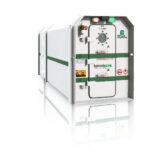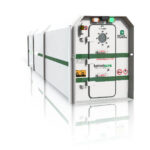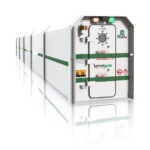Gantry Mounted Chamber
– TunnelSAFE Gantry Design
Gantry mounted chambers are designed to be installed at the rear of the Tunnel Boring Machine (TBM), providing a fixed safe refuge solution for the life of the tunnelling project.
The TunnelSAFE Gantry Design (GD) is available in a standard and wide design, dependent on the size of the cutting head infrastructure and project requirements.
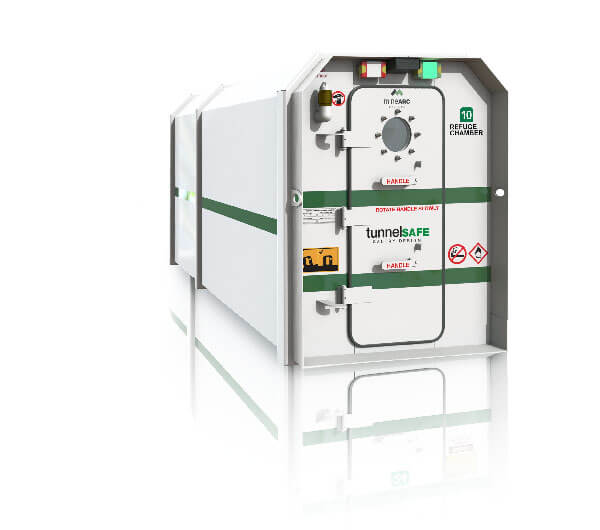
Gantry mounted chambers are highly customisable to suit any tunnelling project and can be built to comply with British Standard (BS EN 16191:2014) Safety Requirements for Tunnelling Machinery or the ITA’s “Guidelines for the Provision of Refuge Chambers Under Construction”.
The TunnelSAFE Gantry Design Refuge Chamber features a standard or wide shell, and is available in a range of occupancies – from 10 to 24 people. It’s dimensions and rated occupancy can be custom-engineered to project specifications, without compromising on safety or performance.
| Model | Occupancy | Compliance | Height (m) | Width (m) | Length (m) | Weight(kg) |
| TS-GD1-10-ELV-24-I | 10-Person | ITA | 2.00 | 1.60 | 5.60 | 4800 |
| TS-GD3-10-ELV-24-E | 10-Person | BS EN | 2.00 | 1.60 | 7.00 | 5950 |
| TS-GD2-12-ELV-24-I | 12-Person | ITA | 2.00 | 1.60 | 6.30 | 5400 |
| TS-GD4-12-ELV-24-E | 12-Person | BS EN | 2.00 | 1.60 | 7.95 | 6200 |
| TS-GD3-14-ELV-24-I | 14-Person | ITA | 2.00 | 1.60 | 7.00 | 5950 |
| TS-GD5-14-ELV-24-E | 14-Person | BS EN | 2.00 | 1.60 | 9.00 | 6450 |
| TS-GD4-16-ELV-24-I | 16-Person | ITA | 2.00 | 1.60 | 7.95 | 6200 |
| TS-GD6-16-ELV-24-E | 16-Person | BS EN | 2.00 | 1.60 | 9.80 | 6700 |
| TS-GD5-20-ELV-24-I | 20-Person | ITA | 2.00 | 1.60 | 9.00 | 6450 |
| TS-GD8-20-ELV-24-E | 20-Person | BS EN | 2.00 | 1.60 | 11.7 | 7200 |
| TS-GD7-24-ELV-24-I | 24-Person | ITA | 2.00 | 1.60 | 10.50 | 6920 |
| Model | Occupancy | Compliance | Height (m) | Width (m) | Length (m) | Weight (kg) |
| TS-GDW1-10-ELV-24-I | 10-Person | ITA | 2.00 | 2.00 | 4.80 | 4900 |
| TS-GDW3-10-ELV-24-E | 10-Person | BS EN | 2.00 | 2.00 | 5.80 | 5450 |
| TS-GDW2-12-ELV-24-I | 12-Person | ITA | 2.00 | 2.00 | 5.30 | 5200 |
| TS-GDW4-12-ELV-24-E | 12-Person | BS EN | 2.00 | 2.00 | 6.40 | 5900 |
| TS-GDW3-14-ELV-24-I | 14-Person | ITA | 2.00 | 2.00 | 5.80 | 5450 |
| TS-GDW6-14-ELV-24-E | 14-Person | BS EN | 2.00 | 2.00 | 7.75 | 6500 |
| TS-GDW4-16-ELV-24-I | 16-Person | ITA | 2.00 | 2.00 | 6.40 | 5900 |
| TS-GDW7-16-ELV-24-E | 16-Person | BS EN | 2.00 | 2.00 | 8.12 | 6750 |
| TS-GDW5-20-ELV-24-I | 20-Person | ITA | 2.00 | 2.00 | 6.80 | 6150 |
| TS-GDW8-20-ELV-24-E | 20-Person | BS EN | 2.00 | 2.00 | 9.86 | 7300 |
| TS-GDW6-24-ELV-24-I | 24-Person | ITA | 2.00 | 2.00 | 7.75 | 6500 |
| TS-GDW9-24-ELV-24-E | 24-Person | BS EN | 2.00 | 2.00 | 11.40 | 7650 |
- Self-regenerative ELV CO and CO2 scrubbing
- Medical O2 regulator and backup
- Positive Pressure Maintenance System with visual reference
- Audio visual warning for pneumatic disruption
- Aura-FX Fixed Gas Monitor
- Air conditioning and dehumidifying
- 5mm steel plate construction with reflective signage
- Water based fire extinguisher (optional for non-Australian orders)
- Full UPS 24hr battery backup system
- Ergonomically designed seating
- Radio power supply
- External strobe lighting; internal fluorescent lighting
- Custom dimensions and transport configurations
- Blast shield protection (reinforced construction)
- Fully Flushing, Pressurised Airlock
- Compressed Air Management System
- Misting system for external temperature control
- Satellite UPS Systemn
- GuardIAN Refuge Chamber Monitoring
- Internal LCD monitor screen
- Step-down transformer
- Carbon Monoxide Safety-Off-System (COSOS)
- Remote video camera monitoring
- Intrinsically safe MARCis Scrubber
- Automated Oxygen Delivery System (AODS)
Supporting Documents
- Designing Refuge Chambers for Tunnels Under Construction
- Monitoring Gas Levels in Tunnelling
- Safety Critical for Underwater Tunnel Construction
- The Lyon-Turin Rail Project
- Small TBM Strengthens Safety with Custom Refuge Chamber
- Methane Detectors for Tunnel Refuge Chambers
- Custom Refuge Chamber for Use on an Incline
Gantry Mounted Chamber – Virtual Tour
Gantry Mounted Chamber – Front View
The ‘face’ of the TunnelSAFE Gantry Design is designed primarily for easy identification and quick access during an emergency. The strobe lighting, warning siren and reflective signage alert passers-by to the chamber’s location, whilst the rotating door handles provide simple, straight forward access to the safety of the interior.
Gantry Mounted Chamber – Interior View
Inside a TunnelSAFE Gantry Design Refuge Chamber, a number of vital life-support systems combine to create a safe, ongoing environment for occupants. Systems include; primary and secondary air (oxygen) supplies, air conditioning systems, positive pressure systems, electrical systems, gas detection and a chemical scrubbing system.
The TunnelSAFE Gantry Design uses active chemicals and MineARC’s ELV (extra-low-voltage) Scrubbing System to ‘scrub’ the build up of harmful CO2 (carbon dioxide) and CO (carbon monoxide) from the air inside the refuge chamber.
Gantry Mounted Chamber – Rear View
A secure cabinet at the rear of the TunnelSAFE Gantry Design houses the refuge chamber’s UPS battery back up (Uninterruptible Power Supply). The UPS is a fail-safe system that can power the refuge chamber’s internal life support systems for a minimum of 36hrs, should mine power become cut-off.
Also at the rear of the chamber is the Compressed Air Management System (CAMS), which allows regulated compressed air into the refuge chamber when the pressure inside drops below 200Pa. This process optimises mine air usage and guarantees against over-pressurisation of the refuge chamber.
CAMS’ gas toxicity monitor automatically diverts compressed air if oxygen levels in the airline fall below a set level (18% oxygen in free air), signifying air contamination. Additionally, the incorporated flood protection valve automatically shuts down compressed air to avoid catastrophic and costly chamber damage in the event of water ingress.
Comparison Table
| Name | Capacity * | ITA/BS EN Compliance ** | Aura-FX Gas monitoring | CAMS | Gantry | Mobile | Portable | 24hrs Battery Backup |
|---|---|---|---|---|---|---|---|---|
 |
8-20 | |||||||
 |
10-24 | |||||||
 |
10-24 | |||||||
 |
10-24 | |||||||
 |
12-24 | |||||||
 |
10-24 | |||||||
 |
12-24 |
- * Capacity Every refuge chamber is built with a certain rated occupancy in mind. The life support systems are designed to safely house this number of people for the designated duration.
- ** ITA/BS EN Compliance MineARC’s TunnelSAFE Refuge Chambers can be built to comply with British Standard (BS EN 16191:2014) Safety Requirements for Tunnelling Machinery and the ITA’s “Guidelines for the Provision of Refuge Chambers Under Construction.
Related Products
Corded Cap Lamp – SiriUS-LUX
Corded Cap Lamp – SiriUS-LUX L3 Corded Cap Lamps from the SiriUS-LUX range redefine wearable LED lighting designed for underground environments. Specially engineered to improve efficiency and visibility to ensure safe operations, the cap lamp is an essential element in Personal Protective Equipment (PPE). MineARC’s own designed and manufactured cap lamp provides a quality and
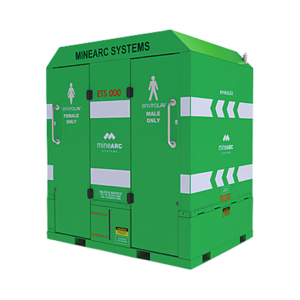
Underground Toilet – EnviroLAV
Underground Toilet – EnviroLAV Underground Toilet technology by MineARC offers the latest innovation in self-contained, portable waste management systems – ideal for use in underground mines, tunnelling construction and remote locations. Designed to be simple to operate and maintain, the EnviroLAV is a semi-permanent structure that can be used both above and below ground wherever




